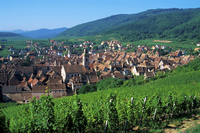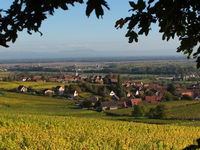For the first decade of my work as a wine writer, I probably devoted more columns in The Washington Post to Riesling from Alsace than any other grape from any other region. I believed then–as I do now–that Riesling was the world’s greatest white wine grape variety, for a whole slew of reasons. However, the general wine consuming public never really took  to Riesling, and I made it my business to tell them repeatedly that they were missing out on something fabulously delicious and food-friendly.
to Riesling, and I made it my business to tell them repeatedly that they were missing out on something fabulously delicious and food-friendly.
Riesling is grown and vinified in many places around the world, but from the mid-1994 until 2005, when I was writing for the Post before leaving to help launch Wine Review Online, Alsace was the primo place of origin for someone like me who was bent on hooking readers on Riesling. German renditions were marvelous but dauntingly complicated and often too sweet for most consumers to use without specific pairing instructions. Austrian Rieslings were just becoming available. Australia made great Rieslings, but nobody here was interested in anything but Shiraz, so importers rarely brought the wines to our shores.
Washington and Oregon were just cranking up production, as were the Canadians in British Columbia and Ontario (all of which are now making wonderful Rieslings, along with Michigan and New York’s Finger Lakes). California Rieslings could be found fairly easily, but most of them were pretty boring, as there’s just too much sun and heat in most of the Golden State to make the sleek, zesty style that most effectively lures wine lovers into Riesling World.
That left Alsace, which made reasonably priced wines that were essentially dry, widely available, fairly priced, and terrific with all sorts of  foods. This last virtue made them my “go-to” whites for Thanksgiving, and I never let a year go by without using that national occasion to preach the Alsace Riesling gospel.
foods. This last virtue made them my “go-to” whites for Thanksgiving, and I never let a year go by without using that national occasion to preach the Alsace Riesling gospel.
But then, about a decade ago, things took multiple turns, and not in good directions for Rieslings from Alsace. Dry Rieslings started appearing in serious numbers from Germany, partly because of a change in drinking fashions in that nation, and partly due to climate change lowering acidity and lowering the need for sugar to balance it. Weirdly, many winemakers in Alsace started leaving more sugar in their Rieslings even as the Germans were moving in the opposite direction, which was a bad move both commercially and stylistically, in my opinion. Austria started sending a lot of dry or barely off-dry renditions, and this is also when Rieslings from Washington, Oregon, Canada, New York and Australia got a lot better and a lot easier to find.
To be sure, exemplary producers like Trimbach never strayed from dry style Rieslings, nor did they ever miss a beat on quality. But the category of Alsace Riesling as a whole slipped badly, moving from a commanding position to just another choice among many, and a dicey choice at that, since the sweetness one would get from any particular bottle was no longer a predictable matter.
I honestly do not know how much this decline from “indispensable” to “also ran” actually hurt vintners’ bottom lines in Alsace, where tourism tends to prop everything up. But I do know that–somehow–the message got through, as Rieslings from Alsace have become notably drier and more consistently excellent in the past few years.
With Thanksgiving now around the corner, the time seems right to profile some strong cases in point. As a teaser, here are five fine bottlings, with more to come in my next column two weeks from now. As you work down the list, the wines will get better as you go, and the ones I’m saving for the column are the best of the best, so be sure to revisit WRO in two weeks:
Domaine Loew (Alsace) Riesling “Muschelkalck” 2012 ($20): I have virtually no experience with this producer’s wines, despite having spent a lot of time in Alsace, but I’ll have an eye peeled from now on. This shows some lovely floral topnotes, followed by taut fruit and a finish that recalls wet stones and oyster shells. Fresh and fun, but with some complexity too. 90
Meyer-Fonné (Alsace) Riesling Réserve 2013 ($25): This is a fine example of the very welcome trend in Alsace toward rendering Rieslings  in a dry, fresh style. The aromas show a bit of positive development with light floral notes, but the palate is flinty and mineral and almost steely. A very energetic wine with lots of linear thrust (as opposed to creamy breadth), this is a very appealing choice for freshwater fish dishes. 91
in a dry, fresh style. The aromas show a bit of positive development with light floral notes, but the palate is flinty and mineral and almost steely. A very energetic wine with lots of linear thrust (as opposed to creamy breadth), this is a very appealing choice for freshwater fish dishes. 91
Gustave Lorentz (Alsace) Riesling Grand Cru Altenburg de Bergheim Riesling 2008 ($60): This house has been on the upswing in recent years, and 2008 was an excellent vintage that shows the boost phase of the ascent. The wine is now probably fully developed, but is at a wonderful stage at the moment, showing just a pleasant whiff of petrol on the nose, but with fruity and flowery scents as well. Rich and rounded but still structured by nice acidity, this is opulent enough to work beautifully with richer fish dishes, turkey and stuffing with gravy, or even slow-cooked pork. 91
Paul Blanck (Alsace) Riesling Grand Cru Schlossberg 2012 ($38): Conspicuously rich, with lots of mandarin and some light tropical notes, this is a big wine for an Alsace Riesling, and yet it is nearly as graceful as it is impressive. Mineral tinges and other nuances emerge as one re-tastes this, and I suspect the wine’s sheer size obscures this layered character at first blush. 91
Josmeyer (Alsace) Grand Cru Brand 2012 ($70): A very lean, fresh expression of Alsace Riesling with a very low 3 grams per liter of residual sugar, this is a bit tight for the moment, but a very classy wine for pairing with lighter seafood dishes now (or somewhat more robust foods after it loosens up and fills out in the many years of positive development that lie ahead for it). 92
1
